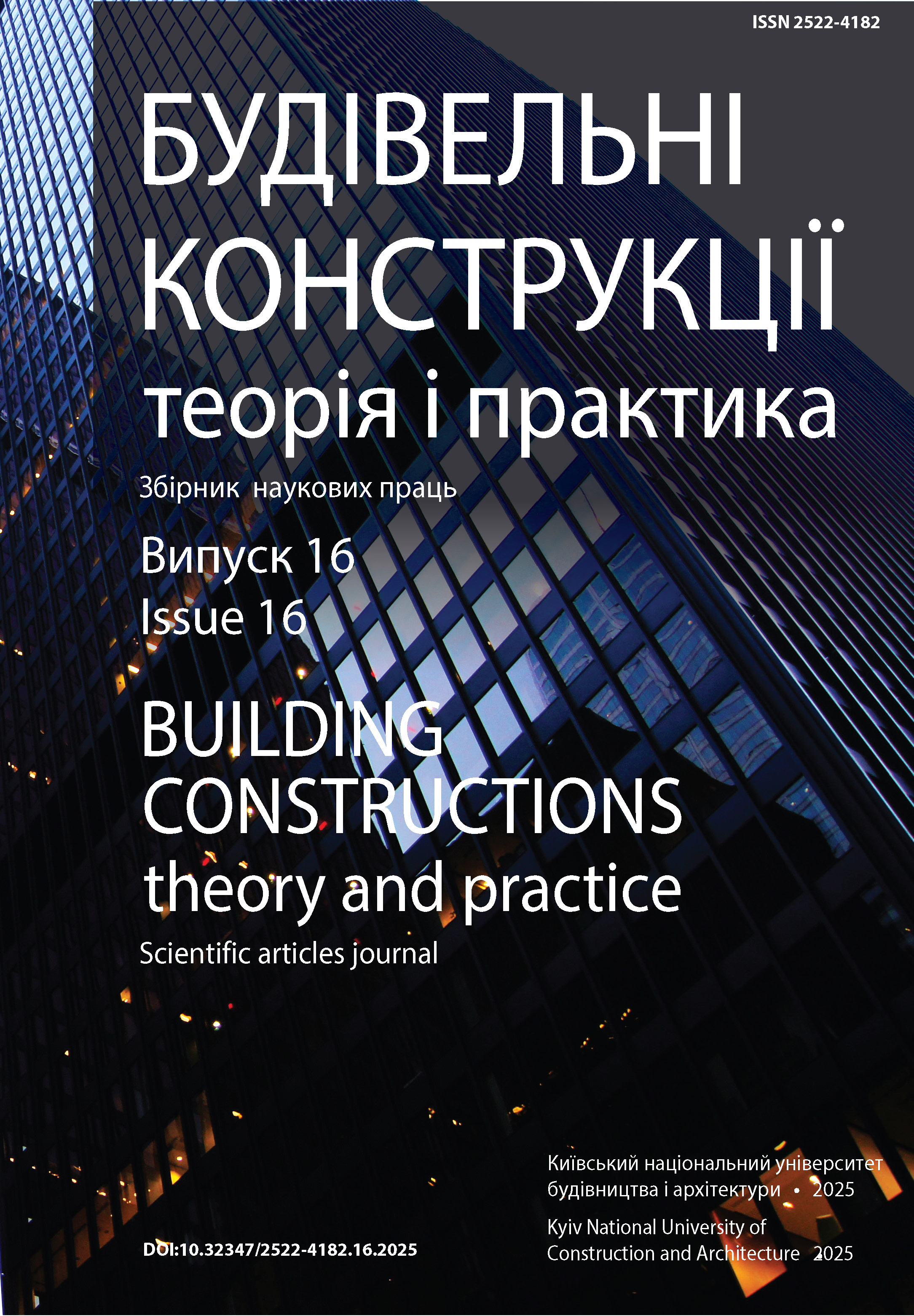Числові дослідження фланцевих вузлів ферм з обрізаними фланцями
DOI:
https://doi.org/10.32347/2522-4182.16.2025.56-65Ключові слова:
еквіваленті напруження, фланець, компонентний метод скінченних елементів, чисельне моделювання, жорсткість вузла, сталева ферма, локальне напруженняАнотація
У сучасному будівництві сталеві ферми залишаються одним із найпоширеніших типів несучих конструкцій, що застосовуються при зведенні будівель промислових, цивільних та громадських будівель. Їх використання обумовлене високою несучою здатністю, відносною легкістю монтажу та економічною доцільністю використання у великопрогонових спорудах.
Одним із найвідповідальніших елементів таких конструкцій є фланцеві вузли, через які передаються основні зусилля від однієї час-тини ферми до іншої. Надійність і довговічність усієї системи в значній мірі залежить саме від якості виконання розрахунку.
Особливої уваги потребують ситуації, коли на вузол діють не тільки осьові навантаження, а й згинальні моменти та кручення, що спричиняють складний напружено-деформований стан. У таких випадках традиційні методи розрахунку, які ґрунтуються на спрощених моделях та припущеннях про рівномірний розподіл напружень, не завжди дозволяють виявити локальні концентрації, які можуть призводити до передчасного руйнування конструкції. З огляду на це, особливо актуальним є удосконалення методик чисельного аналізу з урахуванням реальної просторової геометрії елементів, особливостей з’єднання та характеру навантаження.
Запропонований підхід базується на побудові аналітичної моделі вузла з можливістю розрахунку внутрішніх зусиль у критичних зонах без потреби повного моделювання всієї ферми. Це дозволяє не лише скоротити час, необхідний для виконання розрахунків, а й підвищити їх точність. Такий підхід сприяє ранньому виявленню потенційно небезпечних зон, де можливе перевищення граничного рівня напружень, що, своєю чергою, знижує ризики втрати експлуатаційної придатності.
Посилання
Bilyk, S., Bilyk, A., Tsyupyn, E., Nuzhnyy, V., Klyuchnichenko, T. (2020). Udoskonalennia metodyky rozrakhunku zvarkhnykh shviv flantsevykh vuzliv z’iednanykh iz vrezanymy rebramy zhorstkosti prostorovykh stalevykh ferm z trub [Improvement of the calculation methodology for welded joints of flanged node connections with inserted stiffening ribs in spatial steel trusses made of pipes]. Budivelʹni konstruktsiyi. Teoriya i praktyka, (7), pp. 57-65 [in Ukrainian].
https://doi.org/10.32347/2522-4182.7.2020.57-65
EN 1993-1-8 (2005): Eurocode 3: Design of steel structures – Part 1-8: Design of joints. [Authority: The European Union in accordance with Regulation 305/2011, Directive 98/34/EC, Directive 2004/18/EC].
https://www.phd.eng.br/biblioteca-phd/normas/normas-europeias/3/
Minregion of Ukraine. (2014). DBN V.2.6-198:2014. Steel structures. Design standards. With Amendment No 1 [ДБН В.2.6-198:2014]. [in Ukrainian]
https://www.minregion.gov.ua/dbn
Bilyk, S., But, M., Shpynda, V. (2014). Analiz rozrakhunku boltiv flantsevoho z’ednannia v umovakh skladnoho napruzheno–deformovanoho stanu [Analysis of bolt design in flanged connections under complex stress-strain conditions]. Zbirnyk naukovykh pratsʹ Ukrayinsʹkoho instytutu stalevykh konstruktsiy imeni V.M. Shymanovsʹkoho, (13), pp. 76-84. [in Ukrainian]
http://nbuv.gov.ua/UJRN/ZNPISK_2014_13_9
Bilyk, S., Tonkacheyev, V. (2018). Determination of the limits of inclined load inside a von Mises truss with an elastic support. Materiali in tehnologije, (52), pp. 105-109. http://mit.imt.si/Revija/izvodi/mit182/bilyk.pdf
Shivaji, C. (2014). Stress analysis of flanged joint using finite element method. International Journal of Science and Research. https://www.researchgate.net/publication/317872865_Stress_Analysis_of_Flanged_Joint_Using_Finite_Element_Method
Przemysław, J., Konrad, A. (2019). Design and analysis of flanged-bolted joint considering the required tightness and strength. Open Engineering, (9), pp. 338-349.
https://doi.org/10.1515/eng-2019-0031
Choulei, M. (2022). Stress analysis of bolted flange joints with different shell connections. Montreal: Ecole de technologie superieure universite Quebec.
https://espace.etsmtl.ca/id/eprint/3083/
Jinyan, S., Wei, L., Li, Zh., Yaoyu, Zh., Guanyuan, Zh., Jian, H., Chenming, Zh. (2024). Experimental study on the mechanical behavior of flange joint for steel pipe under axial tension. Buildings (14), pp. 1-19. https://www.mdpi.com/2075-5309/14/8/2282
Bilyk, S., Bilyk, A., Tsyupyn, Y. (2022). Stiykist' pruzhnykh stryzhniv z pochatkovymy nedoskonalostiamy stalevykh ferm z zhorstkymy vuzlamy [Stability of elastic bars with initial imperfections in steel trusses with rigid joints]. Opir materialiv i teoriya sporud, (109), pp. 213-228.
http://opir.knuba.edu.ua/zbirnyk-109/article-1049 [in Ukrainian]
Wardenier, J. (2002). Hollow sections in structural applications. Delft: Delft University Press. https://www.sefindia.org/forum/files/hollow_sections_by_jwardenier_499.pdf
Packer, J., A., Henderson, J., E. (1997). Hollow structural section connections and trusses: a design guide. 2nd ed. Ontario: Canadian Institute of Steel Construction (CISC). https://www.cisc-icca.ca/wp-content/uploads/2019/08/HSS_ConnectionsTrusses_PackerHenderson1997.pdf
Bilyk, S., Yurchenko, V. (2020). Size optimization of single edge folds for cold-formed structural members. Strength of materials and theory of structures, (105), pp. 73-86. http://omtc.knuba.edu.ua/article/view/226082
Bilyk, S., Bilyk, А., Nilova, T., Shpynda, V., Tsyupyn, E. Buckling of the steel frames with the I-shaped cross-section columns of variable web height. Strength of materials and theory of structures, (100), pp. 140-154. http://opir.knuba.edu.ua/files/zbirnyk-100/11-100_bylik.pdf
Saffari, H., Rahgazar, R., Jahanshahi R. (2008). An efficient method for computation of effective length factor of columns in a steel gabled frame with tapered members. Journal of Constructional Steel Research, (64), pp. 400-406.
https://doi.org/10.1016/j.jcsr.2007.09.001
Southwell, R. (1932). On the analysis of experimental observations in problems of elastic stability. Proc., Roy., Soc., London: Series A, p. 135. http://shellbuckling.com/presentations/otherTopics/pages/page_23.html
Urbonas, K., Daniunas, A. (2005). Component method extension to steel beam‐to‐beam and beam‐to‐column knee joints under bending and axial forces. Journal of civil engineering and management, (11), pp. 217-224. https://www.tandfonline.com/doi/abs/10.1080/13923730.2005.9636353
Fei, X., Ju, Ch. (2016). Punching shear failure of concrete-filled steel tubular CHS connections. Journal of Constructional Steel Research, (124), pp. 113–121. https://doi.org/10.1016/j.jcsr.2016.05.010
Ladinek, M., Niederwanger, A. (2018). An individual fatigue assessment approach considering real notch strains and local hardness applied to welded joints. Journal of Constructional Steel Research, (148), pp. 314-325. https://doi.org/10.1016/j.jcsr.2018.06.005
In-Tae K., Young-Soo, J., Duy, K. (2021). Evaluation of tensile strength of painted steel wi local corrosion at structural connections. Journal of Constructional Steel Research, (177), 106449. https://www.sciencedirect.com/science/article/abs/pii/S0143974X20310014
Lu D., Jiaoli L., Yuankiang, Y., Peng, D. (2020). Imperfection sensitivity analysis and DSM design of web-stiffened lipped channel columns experiencing local-distortional interaction. Journal of Constructional Steel Research, (152), 106699.
https://www.sciencedirect.com/science/article/abs/pii/S026382311931626X?via%3Dihub
Bucmys, L., Daniunas, A. (2017). Component Method in the Strength Evaluation of Cold-formed Steel Joints. Procedia Engineering, (172), 143-148. https://doi.org/10.1016/j.proeng.2017.02.036
Zand, A., Badaruzzaman, W., Mutalib, A., Hilo, S. (2017). Rehabilitation and strengthening of high-strength rectangular CFST beams using a partial wrapping scheme of CFRP sheets: Experimental and numerical study. Thin-walled structures, (114), 80-91. https://doi.org/10.1016/j.tws.2017.01.028
Lakshmikandhan, K., Senthil, R., Sanjeevi, A. (2009). Parametric Studies on the Behavior of Steel and Composite Space Structures. International Journal of Space Structures, (25), 169-183.
https://doi.org/10.1260/0266-3511.25.3.169
Fulop, A., Ivanyi, M. (2004). Experimentally analyzed stability and ductility behaviour of a space-truss roof system. Thin-Walled Structures, (42), 309-320.

